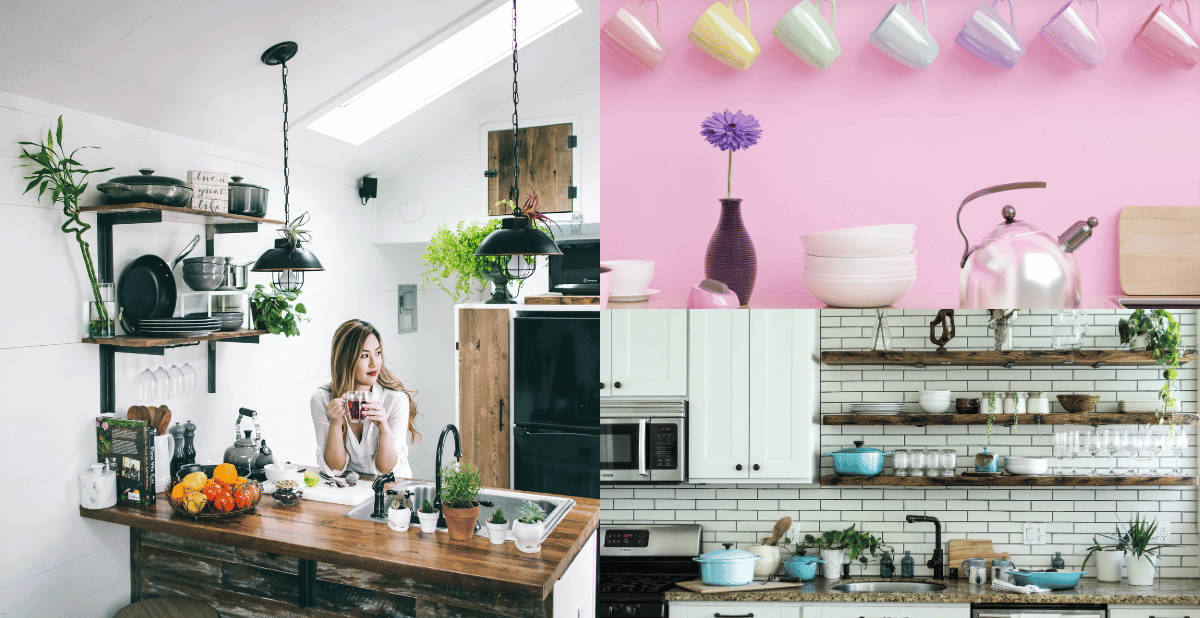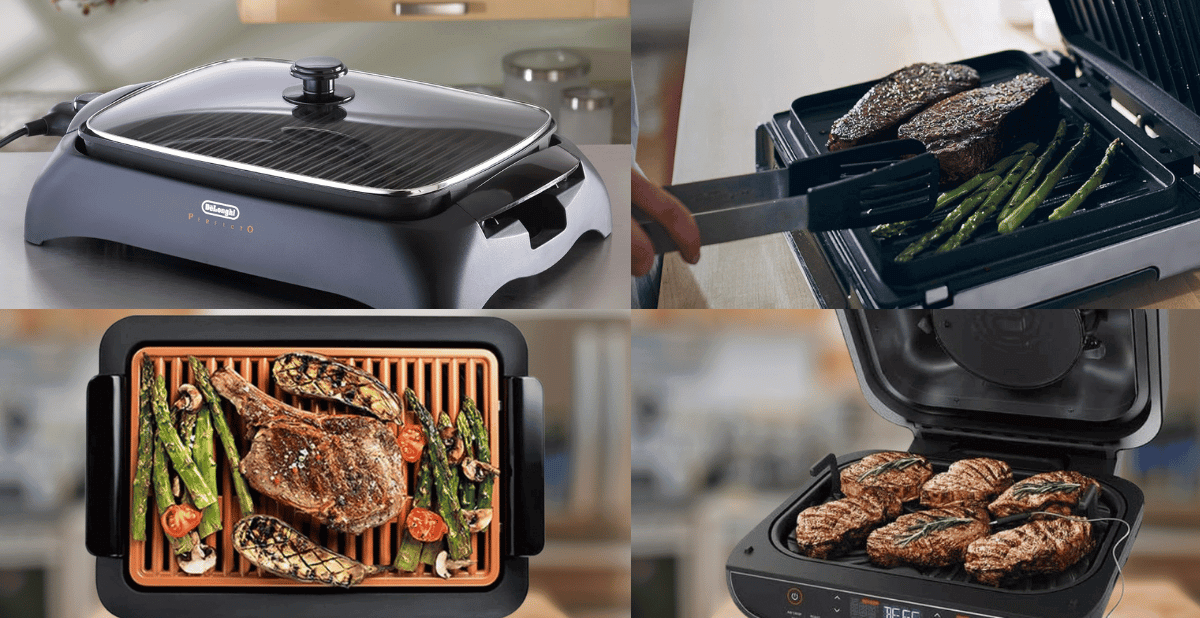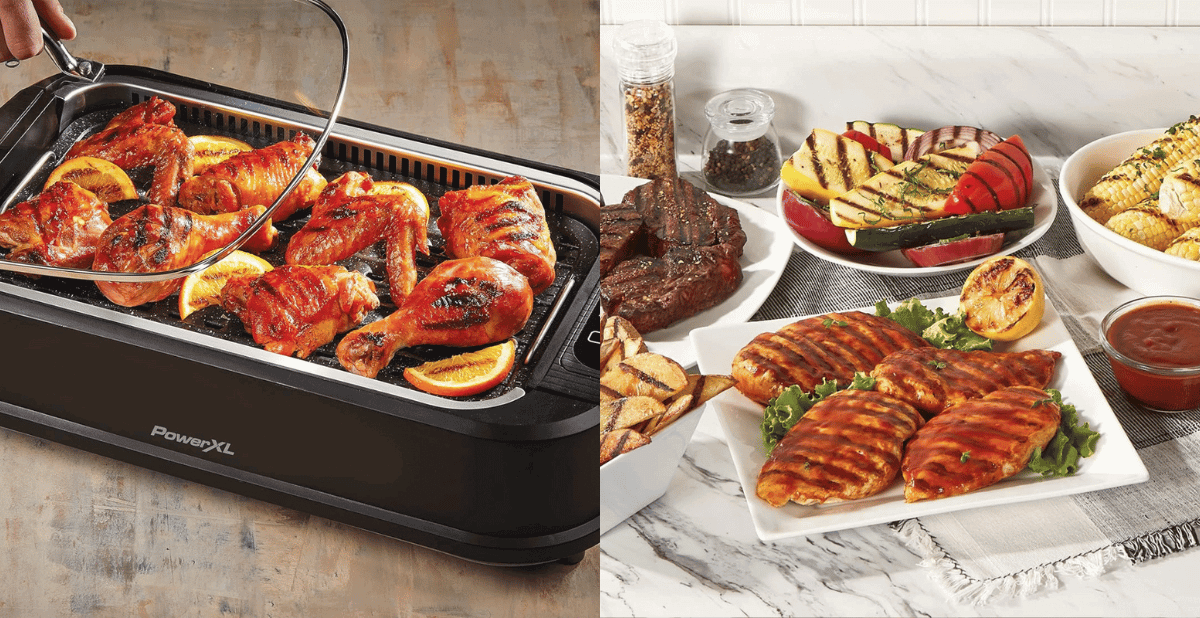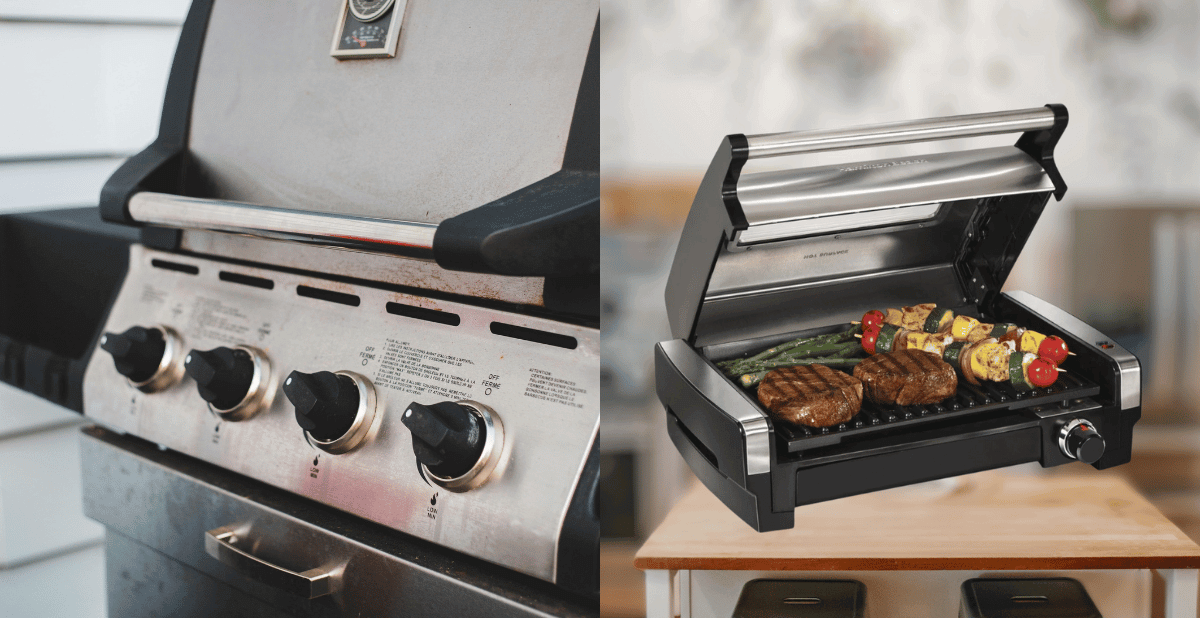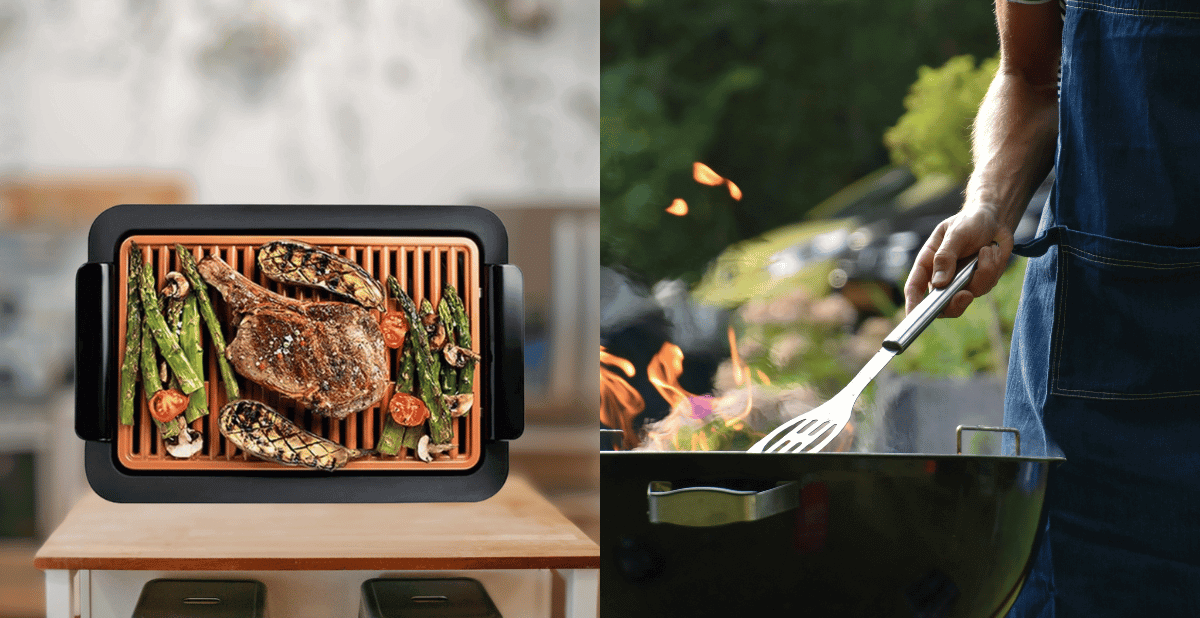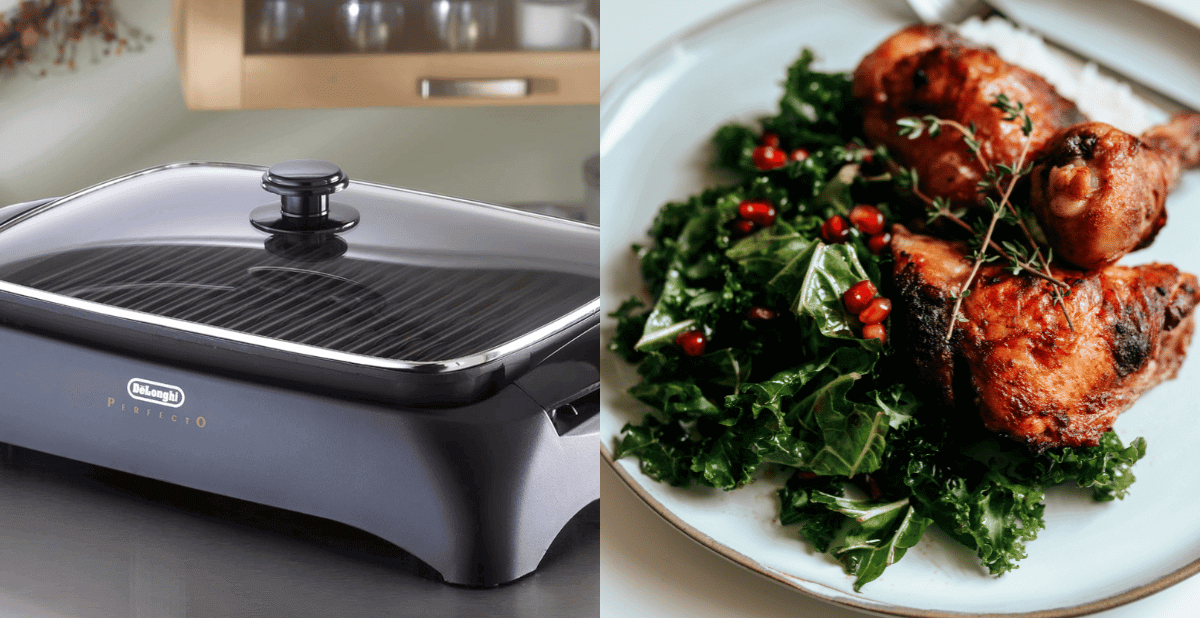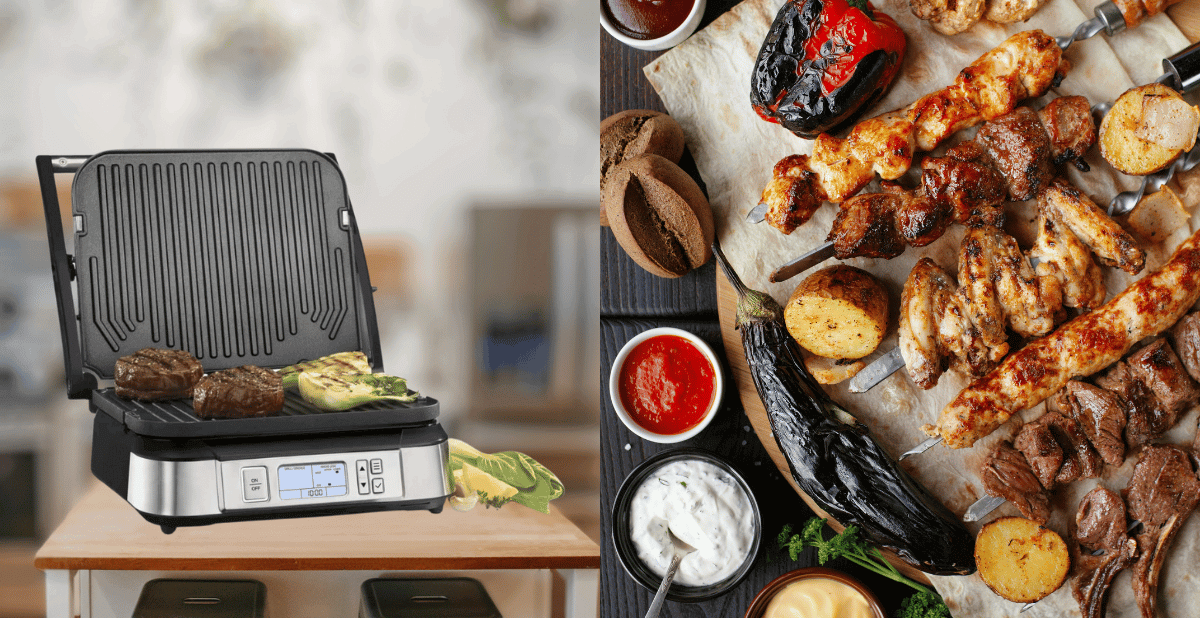For many, grilling is a beloved cooking method, conjuring images of sunny days and social gatherings. But can you use a smokeless grill indoors when the weather isn't cooperating?
The smokeless grill is a game-changer for indoor cooking enthusiasts. This comprehensive guide will explore the ins and outs of using a smokeless grill indoors.
Key Takeaways:
- Smokeless grills are designed for indoor use, offering a grilling experience without the smoke.
- For convenience, they come with various features, such as a griddle plate, removable drip tray, and dishwasher-safe components.
- Understanding the different types of smokeless grills can help you choose the one that best suits your cooking style and preferences.
What is a Smokeless Grill?
Smokeless grills are indoor electric grills designed to provide the grilling experience without the smoke that typically accompanies cooking foods on traditional grills.
They use a heating element to cook food and often include a built-in fan to minimize smoke.
The grill surface is typically designed to prevent flare-ups, which are a common source of smoke when grilling.
The Technology Behind Smokeless Grills
The key to the smokeless grill's ability to be used indoors lies in its advanced technology.
A high-powered heating element heats the cooking surface, while a fan system or infrared technology helps to reduce smoke.
The grill plates are often designed to channel fat and juices away from the heating element into a removable drip tray, further reducing the potential for smoke.
Types of Smokeless Indoor Grills
There are several types of smokeless indoor grills.
Open grills mimic the traditional grill with an open cooking surface, while contact grills like the George Foreman Grill have a lid that cooks food from both sides.
Griddle plates on some models offer a flat cooking surface ideal for foods like pancakes or eggs.
Choosing the Right Smokeless Grill for Your Home
Selecting the right smokeless grill involves considering your cooking style and space.
If you want to achieve good grill marks on chicken breasts or steaks, an open grill with a ridged grill surface might be your best bet.
For those who prioritize easy cleanup, look for models with dishwasher-safe components.
The Benefits of Grilling Indoors
Grilling indoors with a smokeless grill offers several advantages.
You can enjoy grilled food year-round, regardless of the weather.
Additionally, smokeless grills are typically compact and portable, making them suitable for small apartments or homes without outdoor space.
How to Achieve That Smoky Flavor Indoors
One common question is whether you can still achieve that smoky flavor when using a smokeless indoor grill.
While the experience might differ slightly from charcoal or gas grills, some smokeless grills have flavor enhancers or add wood chips to impart a smoky taste to your food.
Safety Considerations When Using an Indoor Grill
Safety is paramount when grilling indoors.
Always use your smokeless grill on a stable, heat-resistant surface, and ensure adequate ventilation to prevent any smoke from triggering the smoke alarm.
Also, never leave the grill unattended while in use.
Cleaning and Maintenance of Smokeless Grills
Proper cleaning and maintenance are crucial for the longevity of your smokeless grill.
Most grills have a removable drip tray and dishwasher-safe grill plates, making cleanup a breeze.
Regularly removing grease and food particles will also help prevent unwanted smoke during cooking.
Grilling Techniques for Perfect Results
To get the most out of your smokeless grill, it's important to master a few grilling techniques.
Preheating the grill ensures a hot cooking surface for searing meats while using the right temperature settings, which can help you cook foods like chicken breasts to perfection without drying them out.
Electric Grill vs. Gas Grill: Understanding the Differences
Have you ever been in the middle of the electric grill versus gas grill debate?
It's a common crossroads for indoor grilling enthusiasts.
Electric grills are celebrated for their convenience and safety, mainly indoors.
They heat up quickly and offer precise temperature control, a boon for those living in apartments or places where open flames are prohibited.
Electric indoor grills are often designed to be portable, making them a versatile choice for cooking food no matter where you are.
On the other hand, gas grills are the traditionalists' choice, often favored for imparting a classic grilled flavor.
They can reach higher temperatures than most electric grills and provide a more authentic outdoor grill experience.
However, they require a well-ventilated area due to the combustion involved, which produces smoke and carbon monoxide.
So, while gas grills can be used outdoors to create a feast for the senses, they're unsuitable for indoor use where ventilation may be limited.
The Advantages of a Contact Grill for Indoor Use
Have you ever wondered why a contact grill might be your new best friend in the kitchen? Let's chat about that.
A contact grill, often a dual-sided grill, simultaneously cooks your food from top to bottom.
This means you're cutting your cooking time in half – talk about efficiency!
Because it's designed to work indoors, you can enjoy perfectly grilled food year-round, regardless of the weather outside.
Now, let's not forget about the health benefits.
Contact grills are fantastic for cooking leaner meals because they typically feature a sloped design that allows excess fat to drip away from your food.
This makes for a healthier plate and contributes to reducing smoke and flare-ups.
So, you can keep all the flavor without all the guilt or hassle of smoke alarms.
It's a win-win situation for those looking to maintain a healthy lifestyle without sacrificing the joy of a good grill session.
How Contact Grills Enhance Meal Prep and Variety
Diving deeper into the world of contact grills, let's explore how they can revolutionize your meal prep game.
Imagine coming home after a long day and being able to whip up a grilled chicken breast or a veggie burger in minutes.
That's the convenience of a contact grill – it's like having a fast-forward button for dinner time.
And because it's so quick, it encourages you to experiment with different recipes and ingredients, adding a dash of spontaneity to your daily meals.
But the versatility continues beyond there. Contact grills aren't just for meats and veggies; they can handle a wide array of foods.
Fancy a panini or a grilled cheese sandwich? Your contact grill has you covered.
Craving some grilled peaches for dessert? Absolutely doable.
This appliance isn't just about grilling; it's about expanding your culinary horizons right from the comfort of your kitchen.
With a contact grill, the possibilities are as limitless as your appetite for adventure.
The Evolution of the Grill Plate: From Charcoal to Electric
The grill plate is the heart of any grilling experience, whether using a charcoal grill, gas grill, or an electric model.
Charcoal grills are all about that traditional smoky taste and the ritual of lighting and tending to the coals.
The grill plate on a charcoal grill gets imbued with flavors over time, adding a depth of taste that's hard to replicate with other types of grills.
However, the mess and effort in setting up and cleaning a charcoal grill plate can deter some people.
Enter the electric grill plate, a modern marvel designed to make grilling more accessible and less messy.
These plates are typically made from non-stick materials, making them easy to clean and maintain.
They heat up quickly and maintain a consistent temperature, perfect for cooking food evenly.
Electric grill plates can be used indoors without worrying about the smoke and ash associated with charcoal grills.
This makes them convenient for grill lovers living in smaller spaces or those who prefer a simpler, more streamlined grilling process.
The Role of a Drip Pan in Smokeless Grilling
The drip pan is an essential component of smokeless grills.
It catches fat and juices that run off the grill grates, preventing them from coming into contact with the heating element and creating smoke.
Ensuring the drip pan is in place and clean is key to a smoke-free grilling experience.
Grilling Vegetables and Other Foods Indoors
Smokeless grills aren't just for meats but are also great for grilling vegetables, fruits, and even sandwiches.
The even heating and controlled temperature make it easy to cook various foods to your desired level of doneness.
The Convenience of a Removable Drip Tray
A removable drip tray contributes to a smokeless environment and adds to the convenience of using an indoor grill.
After grilling, simply remove the tray and dispose of the grease and debris.
Many trays are dishwasher safe, further simplifying the cleaning process.
Comparing Smokeless Grills to Traditional Outdoor Grills
While smokeless grills offer the convenience of indoor use, comparing them to traditional outdoor grills is worth comparing.
Outdoor grills typically provide a larger cooking surface and the ability to cook with different fuels, such as charcoal or gas, which can influence the flavor of the food.
The Impact of Grill Grates on Cooking
The design of grill grates on smokeless grills can affect how your food cooks and looks.
Well-designed grates provide even heat distribution and leave appealing grill marks on your food, enhancing the visual appeal and taste.
The Versatility of Griddle Plates
Some smokeless grills come with interchangeable griddle plates, adding versatility to your cooking options.
These plates are ideal for making breakfast items, searing fish, or cooking delicate foods that might fall through traditional grill grates.
Maximizing Flavor with Marinades and Rubs
To enhance the flavor of your food when using a smokeless grill, consider using marinades and rubs.
These can add depth and complexity to your dishes, compensating for the lack of smoke from charcoal or wood.
The Importance of Adequate Ventilation
Even though smokeless grills produce minimal smoke, ensuring your kitchen is well-ventilated is still important.
This helps to maintain air quality and prevents any lingering cooking odors.
Grilling Indoors Without Setting Off the Smoke Alarm
One of the biggest concerns when grilling indoors is the potential to set off the smoke alarm.
Smokeless grills are designed to minimize this risk, but it's still important to keep the area around the grill clear and to regularly test and maintain your smoke alarm.
The Role of the Heating Element in Smokeless Grills
The heating element is the heart of the smokeless grill, providing the necessary heat to cook your food.
Look for grills with adjustable temperature controls to give you greater flexibility in your cooking.
Until Next Time...
Smokeless grills are a fantastic solution for those who want to enjoy the grilling experience without the limitations of weather or space.
They are designed to minimize smoke, making them suitable for indoor use.
With various types available, from open grills to contact grills with griddle plates, there's a smokeless grill to suit every cooking style.
Safety, proper cleaning, and maintenance are key to ensuring a pleasant and smoke-free indoor grilling experience.
Following the tips and techniques outlined in this guide, you can grill indoors confidently and enjoy delicious grilled foods anytime.
Thanks for visiting,
MommaPuff

